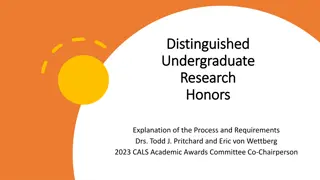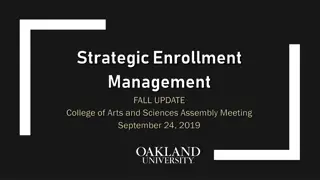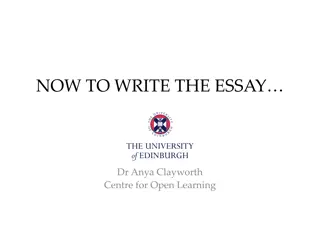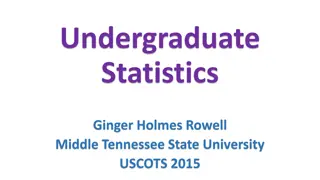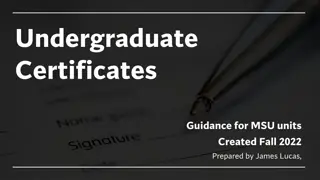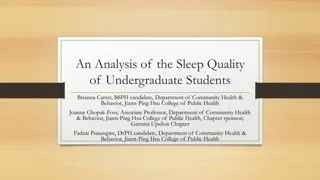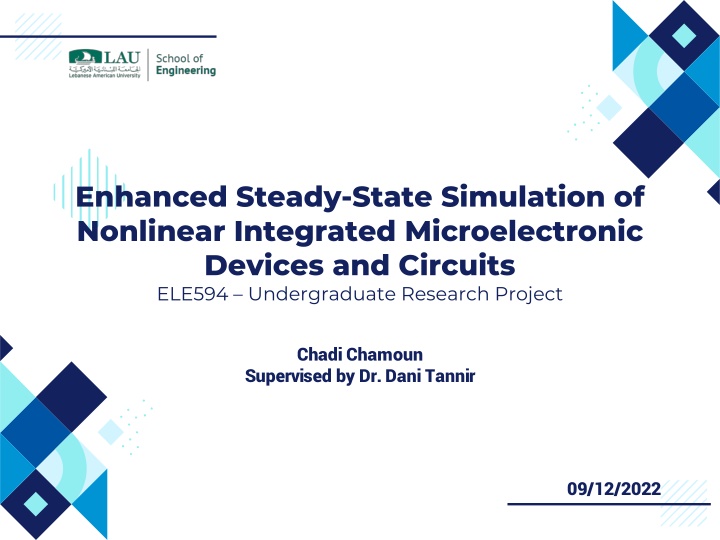
Enhanced Steady-State Simulation of Nonlinear Integrated Microelectronic Devices and Circuits
Explore the enhanced steady-state simulation of nonlinear devices and circuits in this undergraduate research project. Learn about modified nodal analysis, nonlinear device models, and numerical results for efficient electronic design simulation and automation.
Download Presentation

Please find below an Image/Link to download the presentation.
The content on the website is provided AS IS for your information and personal use only. It may not be sold, licensed, or shared on other websites without obtaining consent from the author. If you encounter any issues during the download, it is possible that the publisher has removed the file from their server.
You are allowed to download the files provided on this website for personal or commercial use, subject to the condition that they are used lawfully. All files are the property of their respective owners.
The content on the website is provided AS IS for your information and personal use only. It may not be sold, licensed, or shared on other websites without obtaining consent from the author.
E N D
Presentation Transcript
Enhanced Steady-State Simulation of Nonlinear Integrated Microelectronic Devices and Circuits ELE594 Undergraduate Research Project Chadi Chamoun Supervised by Dr. Dani Tannir 09/12/2022
Outline 1 Introduction General background about nonlinear devices Modified Nodal Analysis Basis of the Modified Nodal Analysis approach 2 Nonlinear Devices and 3 Relations Overview about nonlinear models and nonlinear relations Nonlinear Devices in Harmonic Balance Integration of nonlinear devices in the Harmonic Balance approach 4 Moments and derivatives computation Enhanced approach to compute the steady-state solution 5 Numerical Results Jacobian patterns, speed-up and IIP3 6 2
Introduction Electronic design simulation and automation of various types of circuits is essential. Nonlinear circuits are characterized by nonlinear behavior that should be captured. Obtaining the moments of nonlinear systems allows the study of nonlinear behavior in a circuit. 3
Modified Nodal Analysis (1) Maintains Nodal Analysis Benifits Consists of formulating KCL equations at every node of a given circuit Overcomes Nodal Analysis Limitations By accomodating element characteristics that are current- controlled Automation of Circuit Modeling Unique Element Stamps Every element has a unique stamp that is inserted in the general formulation Can be performed on a simulator such as MATLAB 4
Modified Nodal Analysis (2) General Formulation ?? ? + ??? ? + ? ? ? = ? ? ?? Resistor Stamp Capacitor Stamp Diode Stamp ??? ? ??? ? ??? ? ??? ? 1 ? 1 ??? ? ? =??? ? ??? ? ?(?) ?(?) ? =??? ? ??? ? ? ? ? ? ? = 1 1 ? ? ??? ? ? Independent Voltage Source Stamp ??? ? ??? ? ??? ??? ??? ? ??? ? ??? ??? 0 0 ? ??? ? ??? ? ??? ??? 0 0 0 0 +1 1 0 ? = ? = +1 1 5
Nonlinear Devices and Relations (1) Diode Model Ebers-Moll Model MOSFET in Saturation Model 6
Nonlinear Devices and Relations (2) Nonlinear Device Nonlinear Device Nonlinear Relation(s) Nonlinear Relation(s) ?? ?? ?? Diode ??= ?? ? 1 ? = ?? Nonlinear Resistor ??=1 (??? ??)2 MOSFET in Saturation 2?? ??? = (???? ? + ????(1 ? ? ))??? ??? ?2(1 2? 12?)?(?) Nonlinear Memristor ? ? = ?? 7
Nonlinear Devices and Relations (3) Memristor Stamp ??? ? ??? ? ??? ??? ??? ??? ??? ? ??? ? ??? ??? ??? ??? 0 0 0 0 0 0 0 0 0 0 0 0 0 0 0 0 0 0 0 +1 1 0 0 0 0 0 0 ? = ? = +1 0 1 0 +1 ?? ?? ?? ? 0 0 ??? ? ??? ? ??? ??? ??? ??? ??? ? ??? ? ??? ??? ??? ??? ? = ? = ?1?,??,? ??? ?2?,??,? 8
Nonlinear Devices in Harmonic Balance (1) Nonlinear Algebraic Equations Converts the system of nonlinear differential equations into a system of nonlinear algebraic equations Steady-State Response Used to capture the characteristics of nonlinear circuits Fourier Series Expansion Increased Number of Equations A total of ? = ? ? equations where ? = 2? + 1 with ? being the number of harmonics Input and output signals are periodic 9
Nonlinear Devices in Harmonic Balance (2) General Formulation ? ? + ? ? + ? ? = ? ?0 ?1 ?1 ?? ?? ?0 ?1 ?1 ?? ?? ??0 ??1 ??1 ??? ??? ? 0 0 0 0 0 ? 0 0 0 0 0 ? 0 0 0 0 0 ? 0 0 0 0 0 ? 0 0 0 0 0 0 0 0 ? 0 0 0 0 0 0 0 0 0 0 0 1 0 0 0 ? 0 0 + ? + = ?? 0 ?? 10
Nonlinear Devices in Harmonic Balance (3) The Jacobian can be expressed as ? ? = ? + ? + ? ?? ? where ? ?? ? = 1?? ?? ? ??? ?? ? ?0 ?? ?0 0 ... 0 ?? ? ?1 ?? ?1 ? 0 ... 0 ? ?? ? = 1 ?? ? ?? 1 ?? ?? 1 0 0 ... 11
Nonlinear Devices in Harmonic Balance (4) Number of harmonics ? = 3 Total number of nodes ? = 10 Number of terms in the Fourier series expansion ? = 7 Size of the Harmonic Balance matrices is 70x70 12
Nonlinear Devices in Harmonic Balance (5) Drain voltage as function of time Drain current as function of time 13
Moments and Derivatives Computation (1) Taylor Series Expansion Distortion and Sensitivity Analyses Model Order Reduction (MOR) Reduce large and complex circuit into smaller and simpler circuit while keeping the same characteristics Solution vector is expressed as a Taylor Series expansion Compute the third order intercept point IP3 14
Moments and Derivatives Computation (2) General Formulation ? ? + ? ? + ? ? ??? ? ???= 0 The solution vector can be expressed as a Taylor Series expansion ? ? = ?0+ ?1? + ?2?2+ ?3?3+ = ???? ?=0 To find the zeroth moment ??0+ ??0+ ? ?0 = ??? To find the first moment ??1+ ??1+ ?1= ??? ? 1 ? + ? + ?0??= 1 ? ?=1 ? ? ???? ? 15
Moments and Derivatives Computation (3) Diode Nonlinear Resistor ? 1 ? 1 1 1 ??= ? ? 1 ?0??+ ? ? ? ? ???? ? ??= ? ? ???? ? ??0 ??? ?=1 ?=0 MOSFET in Saturation Nonlinear Memristor ? ? 1 1 ? 2? 2 1 ??= ???? ? ?1,?= ??????? ??1,??? ? ? 2?0 ?? ??0 ?=0 ?=1 ? 1 1 ?2,?= ??2,??? ? ??0 ?=1 ? 1 1 ?3,?= ??3,??? ? ??0 ?=1 ? 1 ? 1 4? 2? 1 2? ??? ?2??? 1 ?4,?= ? ? ?4,??? ?+ ?? 2? ??4,??? ? 2??0 ? ?=0 ?=1 16
Numerical Results Harmonic Balance Jacobian DC Jacobian Harmonic Balance Harmonic Balance Approach Approach Moments Approach Moments Approach Speed Speed- -up up IIP3 IIP3 319.395501 seconds 43.526093 seconds 7.43 16.7 dB 17
Thank You! 18





